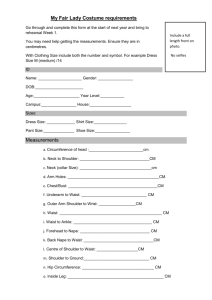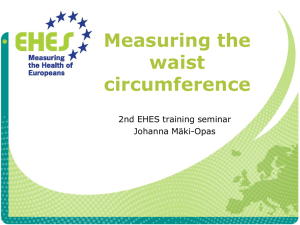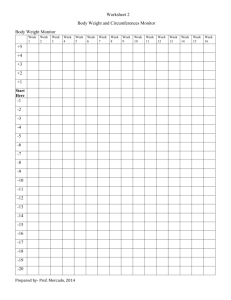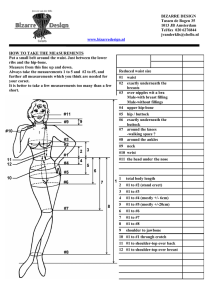Waist Circumference Fact Sheet
advertisement
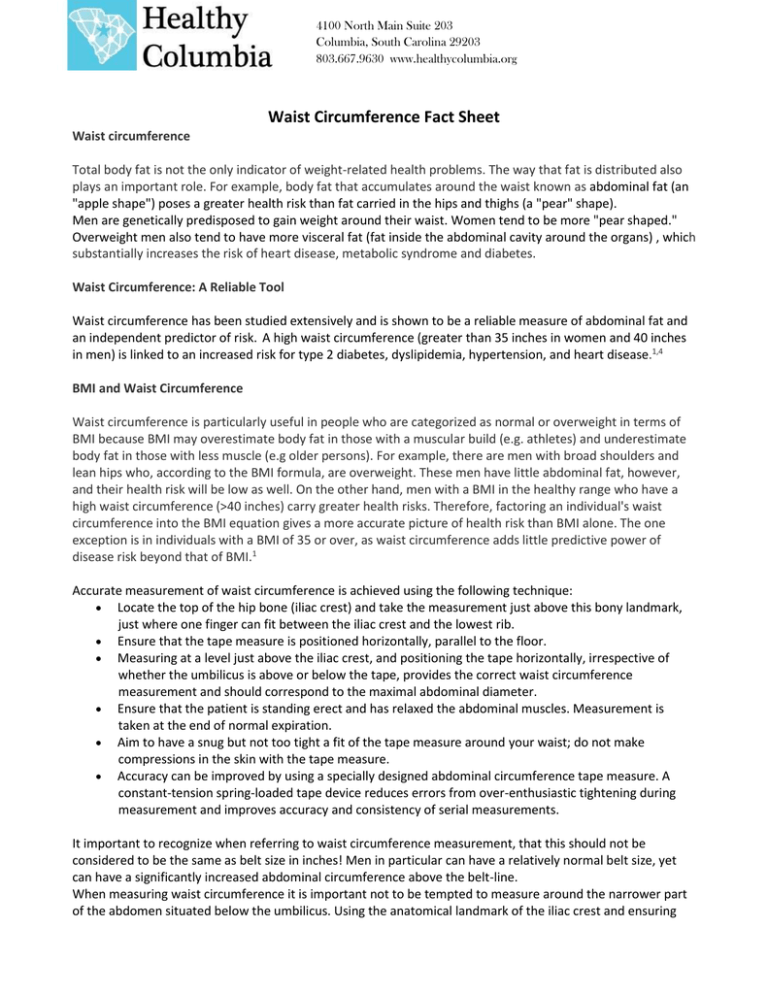
4100 North Main Suite 203 Columbia, South Carolina 29203 803.667.9630 www.healthycolumbia.org Waist Circumference Fact Sheet Waist circumference Total body fat is not the only indicator of weight-related health problems. The way that fat is distributed also plays an important role. For example, body fat that accumulates around the waist known as abdominal fat (an "apple shape") poses a greater health risk than fat carried in the hips and thighs (a "pear" shape). Men are genetically predisposed to gain weight around their waist. Women tend to be more "pear shaped." Overweight men also tend to have more visceral fat (fat inside the abdominal cavity around the organs) , which substantially increases the risk of heart disease, metabolic syndrome and diabetes. Waist Circumference: A Reliable Tool Waist circumference has been studied extensively and is shown to be a reliable measure of abdominal fat and an independent predictor of risk. A high waist circumference (greater than 35 inches in women and 40 inches in men) is linked to an increased risk for type 2 diabetes, dyslipidemia, hypertension, and heart disease.1,4 BMI and Waist Circumference Waist circumference is particularly useful in people who are categorized as normal or overweight in terms of BMI because BMI may overestimate body fat in those with a muscular build (e.g. athletes) and underestimate body fat in those with less muscle (e.g older persons). For example, there are men with broad shoulders and lean hips who, according to the BMI formula, are overweight. These men have little abdominal fat, however, and their health risk will be low as well. On the other hand, men with a BMI in the healthy range who have a high waist circumference (>40 inches) carry greater health risks. Therefore, factoring an individual's waist circumference into the BMI equation gives a more accurate picture of health risk than BMI alone. The one exception is in individuals with a BMI of 35 or over, as waist circumference adds little predictive power of disease risk beyond that of BMI.1 Accurate measurement of waist circumference is achieved using the following technique: Locate the top of the hip bone (iliac crest) and take the measurement just above this bony landmark, just where one finger can fit between the iliac crest and the lowest rib. Ensure that the tape measure is positioned horizontally, parallel to the floor. Measuring at a level just above the iliac crest, and positioning the tape horizontally, irrespective of whether the umbilicus is above or below the tape, provides the correct waist circumference measurement and should correspond to the maximal abdominal diameter. Ensure that the patient is standing erect and has relaxed the abdominal muscles. Measurement is taken at the end of normal expiration. Aim to have a snug but not too tight a fit of the tape measure around your waist; do not make compressions in the skin with the tape measure. Accuracy can be improved by using a specially designed abdominal circumference tape measure. A constant-tension spring-loaded tape device reduces errors from over-enthusiastic tightening during measurement and improves accuracy and consistency of serial measurements. It important to recognize when referring to waist circumference measurement, that this should not be considered to be the same as belt size in inches! Men in particular can have a relatively normal belt size, yet can have a significantly increased abdominal circumference above the belt-line. When measuring waist circumference it is important not to be tempted to measure around the narrower part of the abdomen situated below the umbilicus. Using the anatomical landmark of the iliac crest and ensuring that measurement is taken on a horizontal plane just above this level provides the most accurate, reliable and reproducible technique for waist circumference measurement. Males and Females Females For females, a waist circumference of 35 inches or greater is considered unhealthy. Males For males, a waist circumference of 40 inches or greater is considered unhealthy. Bottom Line Know your BMI and waist circumference numbers. If they are not in the healthy range, it's time to take action and lose weight The chart below details the increased risk of diseases such as type 2 diabetes, hypertension, and cardio vascular disease associated with excess weight What the Results Means Classification BMI Disease risk* relative to normal weight and waist circumference Men less than or equal to 40 inches Men greater than 40 inches Women less than or equal to 35 inches Women greater than 35 inches Underweight less than 18.5 Normal 18.5-24.9 Overweight 25-29.9 Increased High Obese 30-34.9 High Very High Obese 35-39.9 Very High Very High Extremely High Extremely High Extremely Obese greater than 40
